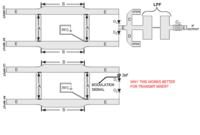Terminator3
Advanced Member level 3
I have doubts on mixer as reciprocal device.
Lets look at single balanced mixer with 90deg hybrid microstrip coupler. It has diode pair connected in series:
https://www.qsl.net/va3iul/Homebrew_RF_Circuit_Design_Ideas/Stripline_Quadrature_Microwave_Mixer.gif
https://www.qsl.net/va3iul/Homebrew...e_Single-Balanced_Narrowband_Hybrid_Mixer.gif
and rat-race mixer:
https://www.qsl.net/yo4hfu/Files/TG/RAT RACE 1296 mixer.pdf
It works good for receiving (obtaining an IF frequency).
Although, let's try to use this mixer as a Transmit Mixer. Now we feeding this mixer with some kHz-range signal on IF port, connected directly to the center pin on mixing diodes. And providing some LO signal. Transmit mixing performance is not good (from experience).
Now if DC-blocking capacitor added in series with diode pair, and IF signal is fed at the point between capacitor and diodes, transmit performance improved. Why?
I modified the image a little to explain the idea (low pass filter part omitted):

I think the same applies to rat-race mixer too!
Also, can such diode pair+dc block capacitor configuration be used for receive mixer? Any drawbacks/advantages?
I think that it can improve voltage swing for RX mixer and less LO power can be used (more sensitive). Not sure.
Lets look at single balanced mixer with 90deg hybrid microstrip coupler. It has diode pair connected in series:
https://www.qsl.net/va3iul/Homebrew_RF_Circuit_Design_Ideas/Stripline_Quadrature_Microwave_Mixer.gif
https://www.qsl.net/va3iul/Homebrew...e_Single-Balanced_Narrowband_Hybrid_Mixer.gif
and rat-race mixer:
https://www.qsl.net/yo4hfu/Files/TG/RAT RACE 1296 mixer.pdf
It works good for receiving (obtaining an IF frequency).
Although, let's try to use this mixer as a Transmit Mixer. Now we feeding this mixer with some kHz-range signal on IF port, connected directly to the center pin on mixing diodes. And providing some LO signal. Transmit mixing performance is not good (from experience).
Now if DC-blocking capacitor added in series with diode pair, and IF signal is fed at the point between capacitor and diodes, transmit performance improved. Why?
I modified the image a little to explain the idea (low pass filter part omitted):

I think the same applies to rat-race mixer too!
Also, can such diode pair+dc block capacitor configuration be used for receive mixer? Any drawbacks/advantages?
I think that it can improve voltage swing for RX mixer and less LO power can be used (more sensitive). Not sure.